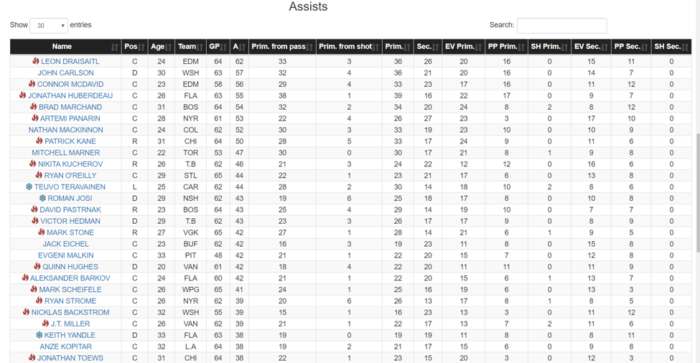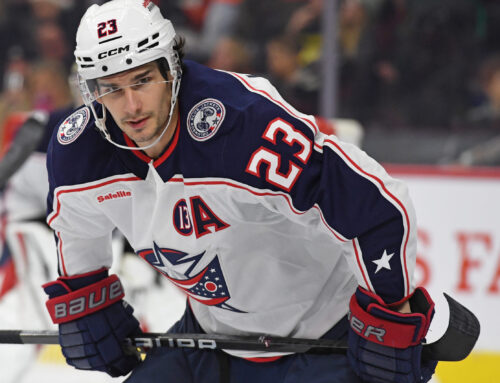Our Dobber Frozen Tools are a cornucopia of data, reports, and charts. The data is only as good as what you use it for though. For example, learning that Artemi Panarin has 53 assists and 17 even strength secondary assists is great, but only if it gives you some information to act on. These articles, then, have several purposes. One is to share something interesting happening in the league, another is to highlight a way to access some useful information, and a third is to show how we can use the information given. This week, as hinted above, we are going to take a look at assists, and more specifically secondary assists.
The Assists report on in Frozen Tools has a number of useful breakdowns. We can for example see who is leading in assists. Leon Draisaitl is thus far leading the way in that category. That is certainly interesting, but hardly unique.

The extra information that we are going to dive into today are the secondary assists numbers, and in particular secondary assists at even strength. Secondary assist numbers have a repuation for being difficult to replicate on a season to season basis. The idea goes that a secondary assist is a bit more random (and therefore less dependent on player skill) than primary assists. We would expect to see a fair amount of variation between players' secondary assist numbers each year.
To take a look at that I took four versions of the above table (2016-17 to 2019-20) to see how player's secondary assist numbers have changed over time. I looked secondary assists as a percentage of a player's total assists. So instead of a straight count we are looking at the proportional of assists that are secondary. I also decided to use even strength assists only as power-play introduces a whole new set of variables. We ended up with 264 players that had secodary assist data for each of the last four years.
To measure I simply took a look at the difference between the percentage of secondary assists a player had each year. For example, Rickard Rakell has 14 even strength assists in 2019-20 with 50 percent of them being secondary. In 18-19, only 22 percent of his even strength assists were secondary. In 17-18 it was 56 percent, and in 16-17 it was back down to 27.27 percent. Over the last three seasons 35.16 percent of his assists have been secondary on average.
| Name | A | 19-20 | 18-19 | 17-18 | 16-17 | Last 3 Av | Av Diff Between Yrs |
| RICKARD RAKELL | 14 | 50% | 22.22% | 56.% | 27.27% | 35.16% | 30.09% |
Rakell is clearly bouncing around a lot. One year he is in the 50-plus percent range, the next in the 25 percent range. That results in an average change each year of 30 percent.
Of the entire sample 104 players have an average difference of over 15 percent (meaning 104 players have a greater average change than 15 percent – like Rakell above who is 30.09 percent). Just as a reference point Mats Zucarrelo, who is right at that 15 percent mark has a 50 percent secondary assist rate in 19-20, a 25 percent assist rate in 18-19, a 30 percent rate in 17-18, and a 45.7 percent rate in 16-17. The moral of this story that even a 15 percent average includes some pretty huge swings, and almost half of the players are more inconsistent than that.
There are only 13 players who have less than a 5 percent average change over the last four seasons.
| Name | Av Diff Between Yrs |
| NAZEM KADRI | 2.50% |
| JONATHAN TOEWS | 3.21% |
| MAX PACIORETTY | 3.30% |
| JASON ZUCKER | 3.33% |
| MATTHEW TKACHUK | 3.37% |
| DEREK RYAN | 4.14% |
| JADEN SCHWARTZ | 4.44% |
| NICKLAS BACKSTROM | 4.60% |
| PAT MAROON | 4.66% |
| ADAM HENRIQUE | 4.84% |
| ANDERS LEE | 4.85% |
| BRETT PESCE | 4.86% |
| AUSTON MATTHEWS | 4.89% |
| DOUGIE HAMILTON | 5.04% |
Again, for reference, that 5 percent mark starts to look more repeatable with Dougie Hamilton's secondary assist rate ranging from between 43 percent and 54 percent.
There are many potential ways to look at secondary assists, and outside of potentially the 13 players listed above much of the secondary assist market appears to rely on luck. Given that we can start to look at where some players are performing and what that might mean for the future. The one caveat is that player's deployment and position may have something to do with it. A forward is more likely to have a higher rate than a defenseman. A guy playing with Conor McDavid is more likely to have passed him the puck to get a point than a guy doing the same thing to Brett Pesce (sorry Brett).
Below I have sorted by the players who have the highest difference between their 2019-20 secondary assist rate and their three-year average (I included three year average to try and help account for position and deployment expectations.) The short story on these guys is they seem to be lucking into more assists at even strength than they should have so far.
| Name | 19-20 | Last 3 AV |
| MARK BOROWIECKI | 90.91% | 37.50% |
| SAMI VATANEN | 100.00% | 49.09% |
| JAKE GARDINER | 100.00% | 50.32% |
| SHEA THEODORE | 72.22% | 27.84% |
| VINNIE HINOSTROZA | 78.57% | 40.48% |
| RADKO GUDAS | 76.92% | 38.94% |
| BRETT CONNOLLY | 63.64% | 27.75% |
| JARED MCCANN | 57.14% | 22.49% |
| YANNI GOURDE | 58.33% | 24.65% |
| ALEC MARTINEZ | 87.50% | 54.17% |
Mark Borowiecki for example is way overperforming. He only has one primary assist to his name at even strength. Sami Vatanen and Jake Gardiner don't have any. The concern here is that if you are relying on these guys for continued point production it isn't likely to come at even strength. A couple of them (Shea Theodore for instance) get power-play time so can do some damage that way, but the ones that don't are likely in for some hurt.
On the flip side there are some very interesting names on the 'unlucky' list.
| Name | 19-20 | Last 3 AV |
| JASON SPEZZA | 20.00% | 49.16% |
| AARON EKBLAD | 38.46% | 66.30% |
| ADRIAN KEMPE | 40.00% | 67.65% |
| RASMUS RISTOLAINEN | 26.32% | 52.80% |
| ONDREJ PALAT | 30.00% | 55.21% |
| CALLE JARNKROK | 33.33% | 58.19% |
| VINCENT TROCHECK | 28.57% | 53.28% |
| JONATHAN MARCHESSAULT | 17.65% | 40.74% |
| ANTHONY MANTHA | 26.67% | 48.37% |
| CHARLIE COYLE | 13.33% | 34.72% |
There are a number of names on this list (Jonathan Marchessault, Jason Spezza, Vincent Trocheck) who have to be performing a bit worse this season than we may have anticipated overall. When we break it down like this, we can clearly see one possible explanation. If they were performing closer to average, they could have expected to see a few more assists. With only a few weeks before fantasy playoffs there is no way to know whether there is still time for a market correction, but these are definitely guys in line for some improvement.
Until next week, thanks for reading.
*
Want more tool talk? Check out these recent Frozen Tool Forensics Posts.





 ANA
ANA CAR
CAR TOR
TOR VAN
VAN PIT
PIT S.J
S.J MIN
MIN STL
STL
